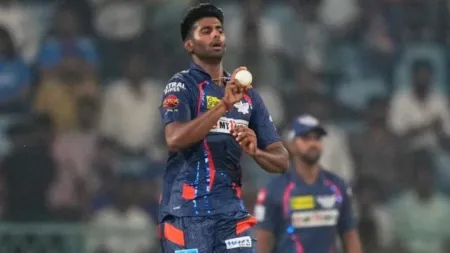Record 39 runs in an over in T20Is: Why Samoan Darius Visser’s six sixes in an over needs to be celebrated despite small ground and a matting pitch
Four months ago, Darius Visser, a cricket coach in a Sydney club, decided to dust up his old dream of playing international cricket. He decided to make use of his mother’s Samoan heritage and took trials with Samoa’s team just before the East Asia Pacific region qualifiers for the T20 World Cup the year after. A batsman who bowls leg-spin—he began his cricket journey with Penrith Cricket Club, and aspired to be a fast bowler like the club’s most famous face, Pat Cummins, but for a spate of stress fractures—he breezed through the trials in time for the tournament.
In only his third game, he wrote history by not only hitting six sixes in an over, but also set a record for most runs in an over 39, off the unfortunate Nalin Nipiko’s nine-ball over, against Vanuatu in Apia on Tuesday.

With a hefty clump over fine-leg—all strikes arrived in the arc between fine-leg and midwicket —he joined an elusive and exclusive group. Only three batsmen have struck six sixes an over in T20Is ever, only seven others have managed the achievement in other forms of the game, in both domestic and international levels. The list features both illustrious and obscure cricketers; it includes Gary Sobers and Ravi Shastri (both in first class), Herschelle Gibbs and Yuvraj Singh; it also features Ross Whitely and Jaskaran Malhotra.
Suspicious eyes would be cast on Visser’s record. The dimensions of the ground, a perfect oval, was predictably modest. The ground itself was small and rustic. The dressing rooms were makeshift tents. The pitch was a green carpet. Behind the black cloth sight-screen flapping in the breeze protruded plantain trees. Even a mishit—though all sixes of his were sweet-spotted and could clear most grounds—could shatter the glasses of the occasional car drawling by, past the scattered coconut trees.
The bowler—medium pacer Nipuko, who the commentator apologetically insisted is better than his ignominious over suggests—was not of the highest calibre. Twice he overstepped, twice he gift-wrapped full tosses, once he bowled a wide, and the rest were length or short balls of inviting pace. A cricketer bred in Sydney would merrily latch on, the game watched by his parents. He would just hang back, shuffle across, clear his front leg, and swipe across the line with a fluid bat-swing and a thumping flourish.
Yet, for all the caveats, the achievement should be celebrated for both its rarity and romance. It is the rarest of cricketing monuments. Statistical milestones are being ceaselessly bettered, its horizons constantly redrawn. The fastest century in T20s was broken twice this year alone. As many as 59 bowlers have picked hat-tricks in this format; two have managed it even twice. Sixes are hit so frequently that it has shed its novelty long ago.
But an all-six over is an imposing feat in cricket, seemingly an act of fate rather than a fruit of design.
It requires a conjunction of several favourable circumstances, and a bestowal of fortune. A highly skilled batsman in a rampaging mood and in destructive touch, batting often towards the end of his own or the team’s innings, on the best day of his life against a bowler enduring the worst day of his life. It happens because it happens, irrespective of a batsman’s rope-clearing prowess. The six-hitting metronome of our times, Chris Gayle, has not managed yet. Neither could Rohit Sharma, or Suryakumar Yadav yet.
Glory and failure are seldom twinned in a single frame as closely as this in the game. For bowlers its devil’s number multiplied by two. They dread this evil union of sixes, just as batsmen dream of this the moment they pick the bat. Not all the unfortunate recipients of the six-infamy are incompetent. Nipiko has 49 wickets in 30 outings, a robust average of 15 and an economy rate of 8.10. The matted pitch was on the slower side, and as the scorecard suggests, it was not a shirtfront. None of Visser’s colleagues mustered more than 16 runs, which too is a record, the highest run percentage (132 off 62) by a batsman in a T20I innings.
More famous names have endured Nipiko’s agony. Like Stuart Broad, the recipient of Yuvraj’s assault, retired as the second most prolific seamer in Test cricket. The incident resolved him to bounce back stronger. “I think it steeled me up to make me the competitor I am, and has driven me forward a huge amount.” Malcolm Nash, the left-arm seamer from Wales who Sobers clobbered, enjoyed a distinguished first-class career of 993 wickets. Nash would remember the incongruously short fine-leg boundary. “There was a little short boundary on the leg side. It would have been an under-13 pitch. And I’ve hit a few sixes here myself, of course!” he told The Cricketer, a year before his death in 2019. Three months before his death, Nash wanted Sobers to sign his autobiography Not Only, But Also. The legendary all-rounder accepted the invitation and shared a couple of drinks too.
The closest feat to hitting six sixes in an over perhaps is a bowler grabbing all ten in an innings, which has occurred only thrice in Test cricket, though on 84 instances in first-class cricket. Peak 6, thus, is a more difficult scale to scale. But it makes unlikely men famous, like a failed club cricketer from Sydney.
Disclaimer: The copyright of this article belongs to the original author. Reposting this article is solely for the purpose of information dissemination and does not constitute any investment advice. If there is any infringement, please contact us immediately. We will make corrections or deletions as necessary. Thank you.





